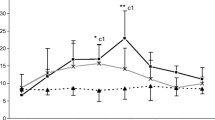Abstract
Forty nine patients with mycologically confirmedTinea cruris were investigated for the association of hypersensitivity to trichophytin and the isolation of dermatophytes from clinically normal sites with chronicity and recurrence of infection. At the end of six months following specific therapy, 24 patients returned for follow up and they were similarly studied. Dermatophytes were isolated from clinically asymptomatic sites in 46% patients before treatment and in 21% of the patients on follow up. Immediate weal reaction and increased concentration of IgE antibodies were seen in 73% and 80% of the patients respectively. However, the delayed hypersensitivity reaction was more associated with patients having lesions for more than 6 months (48%) in comparison with patients with a short history (17%). On follow up after 6 months, the different hypersensitivity reactions and IgE antibody concentration maintained more or less the same association. Therefore in persistent or recurrentTinea cruris infection, besides potential carriage in clinically normal sites, hypersensitivity to antigens of dermatophytes possibly plays an important role in pathogenicity.
Similar content being viewed by others
References
Shah HS, Amin AG, Kanvinde SM, Patel GD. An analysis of 2000 cases of dermatophytosis. Indian J Pathol Bacteriol 1975; 18: 32–37.
Sharma SC, Talwar P, Kumar B, Sharma M, Kaur S, Bedi TR. Tinea cruris in Chandigarh. Indian J Dermatol Venereol Leprol 1980; 46: 216–217.
Rippon JW. Medical Mycology: The pathogenic fungi and the pathogenic actinomycetes, 3rd ed. Philadelphia: WB Saunders, 1988; 169–275.
Kwon-chung KJ, Bennett JE. Medical mycology. Philadelphia: Lea & Febiger, 1992: 105–161.
Chakrabarti A, Sharma SC, Talwar P. Isolation of dermatophytes from clinically normal sites in patients withTinea cruris. Mycopathologia 1992; 120: 139–141.
Svejgaard E, Christiansen AH, Sahl D, Thomsen K. Clinical and immunological studies in chronic dermatophytosis caused byTrichophyton rubrum. Acta Derm Venereol (Stockh) 1984; 64: 493–500.
Stahl D, Svejgaard E. Lymphocyte transformation in vitro in acute dermatophytosis: A follow up study. Acta Derm Venereol (Stockh) 1982; 62: 289–93.
Jillson OF, Huppert M. The immediate weal and the 24–48 hour tuberculin type edematous reaction to trichophytin. J Invest Dermatol 1949; 12: 179–185.
Svejgaard E, Jakobsen B, Svejgaard A. HLA studies in chronic dermatophytosis caused byTrichophyton rubrum. Acta Derm Venereol (Stockh) 1983; 63: 254–255.
Hashimoto T, Emyanitoff RG, Mock RG, Pollack JH. Morphogenesis of arthro-conidium in the dermatophyteTrichophyton mentagrophytes with special reference to ontogeny. Can J Microbiol 1984; 30: 1415–1421.
La Touche CJ. Scrotal dermatophytosis. Br J Dermatol 1967; 79: 339–344.
Davis CM, Garcia R, Riordon JP, Catlin G. Dermatophytes in military recruits. Arch Dermatol 1972; 105: 558–570.
Khudsen EA. The real extent of dermatophyte infections. Br J Dermatol 1975; 92: 413–416.
Chakrabarti A, Sharma SC, Chander J. Epidemiology and pathogenesis of paranasal sinus mycoses. Otolaryngol Head Neck Surg 1992; 107: 745–750.
Author information
Authors and Affiliations
Rights and permissions
About this article
Cite this article
Chakrabarti, A., Sharma, S.C., Handa, S. et al. Association of hypersensitivity and carriage of dermatophytes in clinically normal sites in patients withTinea cruris . Mycopathologia 131, 71–74 (1995). https://doi.org/10.1007/BF01102881
Received:
Accepted:
Issue Date:
DOI: https://doi.org/10.1007/BF01102881




